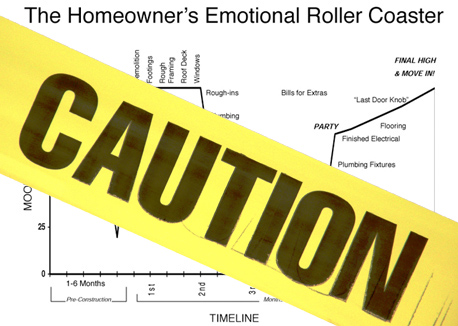My life philosophy is to take the pain early, not just in my design and construction business, but in all things. Putting things off never makes bad things go away, and putting the bad news out front usually ends up with much less total pain. Sounds reasonable, but you may be asking yourself: How does this situation relate to construction? Well, here’s a rule worth keeping in mind:
Be very clear with prospective clients early on how you do what you do. If they don’t like the way you work or the procedures you want them to follow, you’ll be money ahead in the long run to find another client.
You need to explain your design and construction procedures in advance, because your clients need to understand them and agree to them at the outset. If they are unwilling to follow your procedures, then you want to know it earlier, not later. After all, if they don’t like your procedures, do you really want them as a client?
QUALIFY YOUR CLIENTS
Given the economic climate, turning away a client is a difficult decision to make, but as some of you may have already personally discovered, some “problem” homeowners aren’t worth your time and energy, let alone your emotional well-being. By reviewing how you manage a project with your prospects before a job even starts, you are, in essence, taking them through a qualification process. If they agree to follow your procedures—and you estimate and manage the project correctly—you’ll have a good chance of making money. If they don’t seem thrilled by your presentation and you suspect they may turn out to be too emotional and distrusting to let you do your job the way you need to do it, then they may be the problem clients you don’t need. Consider this a gift: If they’re arguing with you for control at this early stage, they’re letting you know right up front that they intend to “help you” manage their project.
Most design professionals have worked with problem homeowners at some point in their career. And if you ask them, “When did you know they were going to be a problem?” a surprising majority will tell you they knew during the first meeting. How did they know? Perhaps they picked up on some subtle signals, but when pressed to be more specific, they often can’t say much more beyond “something just didn’t feel right.”
TRUST YOUR GUT
Pay attention to the mixed feelings you may be having in response to potential clients. As experienced designers will tell you, difficult homeowners will let you know early on that they will be difficult. They may not communicate it verbally, but in the course of your first meeting with them, they’ll send certain signals. Naturally, you may not recognize them intellectually, especially if you’re just starting out. Or you may get a gut feeling but ignore it and take the client on anyway because you need the money, are trying to keep someone on your staff busy or are feeling particularly good about yourself and think to yourself: “I can handle this. I’ve dealt with worse people than this.”
But ignoring your gut feeling can lead to some bad and expensive experiences. Working with problematic homeowners will rarely make you money, as they often lead to project delays, and by taking them on as clients, you could destroy the morale of your company. Carpenters and tradespeople don’t like going to the job, people who answer the phones don’t like speaking to these homeowners and worse yet, you don’t like going to work.
So when you get that bad feeling and you’re wondering about whether you should work with a prospective client, invite a project manager or carpenter to join you at a meeting with them. After the meeting, ask for their impressions. Hearing about their experience of the meeting and their response to the prospect can help you clarify your own mixed feelings. If something is left unsettled or is unsettling after these initial project meetings, make a decision on whether to continue or, if you decide to do so, address the problem immediately.
Remember, you are the expert. You establish the boundaries. You have set job procedures and if everyone involved agrees to them and follows them, the project will run smoothly, deadlines will be met, and you will make money. If a prospect seems unwilling to abide by your guidelines, consider moving on. After all, clients you have enjoyed working with and who appreciate and respect what you do will pay you what you’re worth. And even in this economy, they’re out there waiting for you.
—David Lupberger is ServiceMagic.com’s Home Improvement Expert. He draws on more than two decades of experience in the residential remodeling field, working with remodelers to develop proven business systems. More than 90 percent of Lupberger’s work came from repeat and referral business, demonstrating the trust he developed with clients. That experience led him to write a book called Managing the Emotional Homeowner, which has become one of the bibles of the remodeling industry. Lupberger’s “Ask Dave” column on Proconnection.ServiceMagic.com is a tremendous resource for professionals.
Missed the earlier installments? Read from the beginning:
The Emotional Homeowner 2: Building Trust









